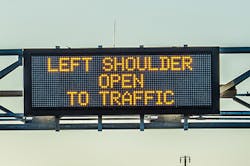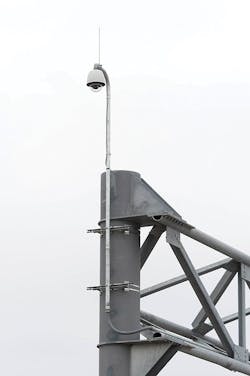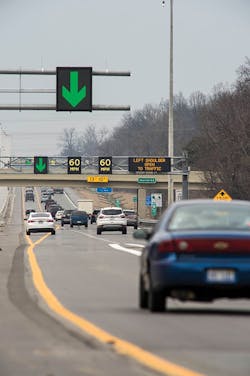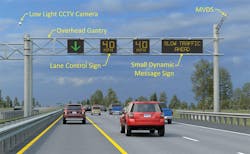Another stride forward
In 2017, the Michigan Department of Transportation (MDOT) opened its first Flex Route along U.S. 23 in Washtenaw and Livingston counties. For years, the problems of peak-hour directional traffic, incident management, and corridor operations and safety eluded the department. All short-term solutions for congestion, operations, and incident management were exhausted through the implementation of an intelligent transportation system and expansion of a Freeway Courtesy Patrol. However, a long-term solution to adequately address safety, recurring and non-recurring congestion, and incident management was still needed. Due to the state’s infrastructure funding challenges and an estimated construction cost of over $185 million to widen the U.S. 23 corridor, MDOT investigated other innovative ways to solve the corridor’s operational and safety problems. The Flex Route was the solution.
Completed in 2017, the U.S. 23 Flex Route runs 9 miles from M-14 to M-36 north of Ann Arbor. The project included construction of road, bridge, and interchange operational improvements and active traffic management (ATM) strategies to address daily recurring and non-recurring traffic, incident management, and overall motorist safety. Using the route’s lane-control gantry system, MDOT can now dynamically manage recurrent and non-recurrent congestion through technology and operational ATM strategies including dynamic lane control and shoulder use, variable speed advisories, and queue warning.
Using the U.S. 23 Flex Route lane-control gantry system, MDOT can manage traffic through lane control and shoulder use, variable speed advisories, and queue warning.
Historically, other states have used hard shoulder running (HSR) on the right shoulder. Michigan was one of the first states to use an ATM strategy on the left or median shoulder. Due to the geometrics of the U.S. 23 corridor, the use of the right shoulder would have cost more. MDOT determined that the left shoulder would be the best for the HSR application.
Dynamic message signs (DMS), microwave vehicle detection systems (MVDS), closed-circuit television (CCTV) cameras, and fiber-optic cable are all being used on the project in a new and innovative way. The DMS being used are full-color LED lane-control signs above each lane and provide graphical information for drivers.
Dynamic lane-control combined with dynamic shoulder use will improve traffic conditions during incidents by safely moving traffic around a crash. The use of variable speed advisories and queue warning will reduce secondary crashes by providing advanced notice of conditions such as identifying the affected lane and warnings to reduce speed.
The U.S. 23 Flex Route has improved travel time by 32% during the morning peak hours.
Real-time data is being used to actively manage traffic to open the shoulder, harmonize speeds, warn drivers of conditions ahead and respond to incidents. Speed, MVDS, and vehicle density are provided for the software to analyze for variable speed advisories and to ensure that traffic conditions meet the thresholds to open or close the shoulder lane. MDOT analyzed the volume data and determined the thresholds for both northbound and southbound U.S. 23. To utilize the hard shoulder and improve the capacity of the corridor, MDOT determined the operating times from the thresholds displayed in Figure 1. During development of the software, MDOT also determined that the maximum speed displayed on the corridor would be 60 mph (posted speed is 70 mph). This was an agreement made between MDOT and the Federal Highway Administration (FHWA) due to the design speed of the shoulder. A queue warning system was implemented to reduce rear-end crashes. The queue warning system is automatically detected when speeds drop below 60 mph. The software will prompt the operator to activate the variable speed limit (VSL). As speeds drop, the software reduces the speeds on the signs in increments of 10 mph.
In addition to using the VSL for speed harmonization, MDOT has worked closely with the Michigan State Police to determine safe thresholds during winter storm events. Michigan roads can be hazardous. To aid drivers with information during winter storm events and per the direction of the police department, the maximum speed will be posted at 40 mph. The VSL will return to automatic operating procedures as conditions improve.
For the Flex Route to be successful, it must be actively managed. Since the beginning of development, MDOT has established procedures to monitor travel times, planning time index, speeds along the corridor, crash history, and operation and maintenance costs. MDOT also has solicited feedback from the public, local agencies and emergency responders.
Figure 1. MDOT determined hard shoulder operating times based on peak traffic volumes.
Since deployment, the U.S. 23 Flex Route has improved planning time by 57% and travel time by 32% during the morning peak hours, and corridor speeds have increased by approximately 20 mph. MDOT anticipates that over time the incidents of primary and secondary crashes will be reduced. Overall, the U.S. 23 Flex Route has improved congestion and advanced transportation systems management and operations for the corridor. It also has had a significant impact on the reliability, safety and mobility for the motorists who travel this route.
In 2018, MDOT received national and state recognition when the U.S. 23 Flex Route project was awarded the highest engineering honors from the American Association of State Highway & Transportation Officials (AASHTO), the American Council of Engineering Companies (ACEC), the Conference of Minority Transportation Officials (COMTO), the Intelligent Transportation Society of America, ACEC of Michigan and COMTO Michigan. Through these awards, the project and the project team were recognized for industry innovation as well as for transportation system safety and operations.
According to Michigan Gov. Rick Snyder, “The U.S. 23 Flex Route is one more advancement toward improving economic growth in Michigan. It fits in perfectly with the Planet M initiative, as well as mobility, education, and research and development partnerships like M-City and the American Center for Mobility. Michigan is a world leader in transportation mobility; however, it isn’t just about autonomous and connected vehicles. Transportation mobility also is about smart infrastructure. The U.S. 23 Flex Route is a perfect illustration of the future of V2I and smart infrastructure technologies. If you want to catch up with the world of transportation mobility, come to the great state of Michigan so we can show you all that we are accomplishing.”





